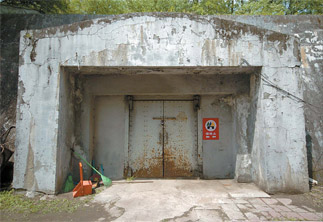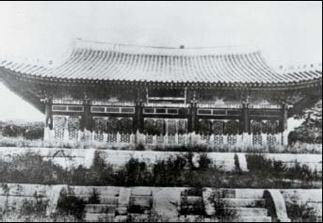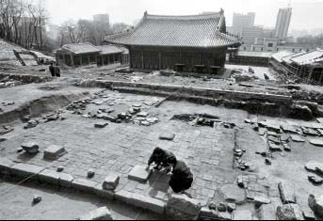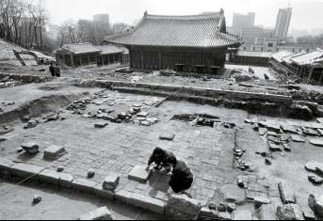The locked gateway to a colonial past

The bunker near the Seoul Museum of History.
The place looks abandoned. There’s just a couple of brooms, a wooden cart and a metal dumpster filled with broken chairs and trash.
A group of teenage boys on a school trip to the nearby museum were lighting up cigarettes the afternoon I visited.
Other passers-by didn’t give the building a second glance.
They’d probably just had their lunch and had no time for looking at decrepit bunkers hidden away in this parking lot.
They were oblivious to the history around them, though you couldn’t blame them.

Gyeonghui Palace at the end of the Joseon Dynasty.
The bunker is located behind the Seoul Museum of History, next to the west wing of Gyeonghui Palace in downtown Seoul.
Unlike the decommissioned tram nearby that, according to information provided, worked the streets from Cheongnyangni to Seodaemun from the 1930s to 1968, the bunker is anonymous.
There are no clear signs to indicate what was behind the steel doors. No information booth to sell tickets to this closed-off part of the city.
It’s ironic that right beside a museum containing so much information about the history of Seoul, this bunker is closed to the public, and there seems little chance that it will ever be opened up.
“Nobody walks in and out of the bunker,” said a parking attendant. “The Jongno District Office has shut the doors.”
The padlock on the steel doors looks like it’ll never open again.
Hwang Mi-young of the district office said visits to the bunker, including media trips, have been prohibited this year because of safety concerns. There’s now a danger the roof or walls could cave in. Last year museum staff used the bunker as a rest area.
It leads to the basement of the former Japanese General Government building in Gyeongbok Palace, which is located to the east of Gyeonghui Palace.
It was built between 1943 and 1944. The Japanese forced captured Korean independence fighters to provide the labor.

Restoration begins on the palace in the 1980s.
The bunker was discovered in the mid- 1980s.The Seoul government was conducting a survey for the restoration of Gyeonghui Palace when workmen uncovered it.
Some people say the Japanese deliberately built the bunker in its current location to cut the flow of the Joseon kings’ chi, or energy.
It stands where the Joseon kings and queens slept in rooms known as Yoongbokjeon and Hoesangjeon.
The fortifications around the bunker are strong, for those days. The rusted steel door at the entrance is 20 centimeters (7.87 inches) thick.
The bunker is known to be 105 meters long (344.49 feet) and its walls are three meters thick and three meters high. The total bunker area is 924 square meters.
If you peak through a gap in the steel door, you can catch the musty scent of an abandoned building on the cold breeze.
To be honest, a chill ran down the back of my neck.
It’s unnerving to think that Koreans who had been arrested fighting for independence had been forcibly coerced into building the bunker.
“It’s a really big area that also has wide partitions and a basement,” said Hwang Pyeong-woo, head of Korea Cultural Heritage Policy Research.
Hwang said if the Korean government has no other plans for expanding the restoration of Gyeonghui Palace, the bunker could be turned into a museum or exhibition hall.
“Historically it really doesn’t have much significance,” said Hwang.
“Nevertheless, it is the last bunker built during the Japanese colonial period known to be in existence,” he added.
Hardly any remnants of colonial history remain in Seoul.
“[The bunker] is one of the few relics left in the capital directly connected to the Japanese occupation, especially since the Korean government demolished the Japanese General Government Building [in Gyeongbok Palace].”
Hwang said the government could use the bunker as an education site where the younger generation could learn about the Japanese occupation.
In 2003, the Seoul government knocked down another military bunker built during the Japanese occupation.
It was in Changdeok Palace.
Gyeonghui Palace is known as the palace of misfortune when it comes to colonial history.
It is said that its scars can’t be healed.

The palace after restoration work was completed.
Buildings within the palace grounds, including the entrances were demolished.
In 1910, the Japanese built Gyeongseong Middle School there.
Other parts were relocated to various Buddhist temples and parks.
After Korea gained its independence in 1945, Gyeongseong Middle School changed its name to Seoul High School. It remained within the palace grounds until 1980. The school was then moved to Seocho-dong in Gangnam, southern Seoul.
Restoration of the palace began in 1988. The main palace building and the surrounding areas have been restored to their original appearance. The bridge that was the main entrance to the palace has also been renovated.
But we are unlikely to see the bunker near the history museum renovated. Its steel doors will stay closed, imprisoning memories from the last days of the Japanese occupation of Korea.
By Lee Ho-jeong Staff Reporter [ojlee82@joongang.co.kr]










with the Korea JoongAng Daily
To write comments, please log in to one of the accounts.
Standards Board Policy (0/250자)